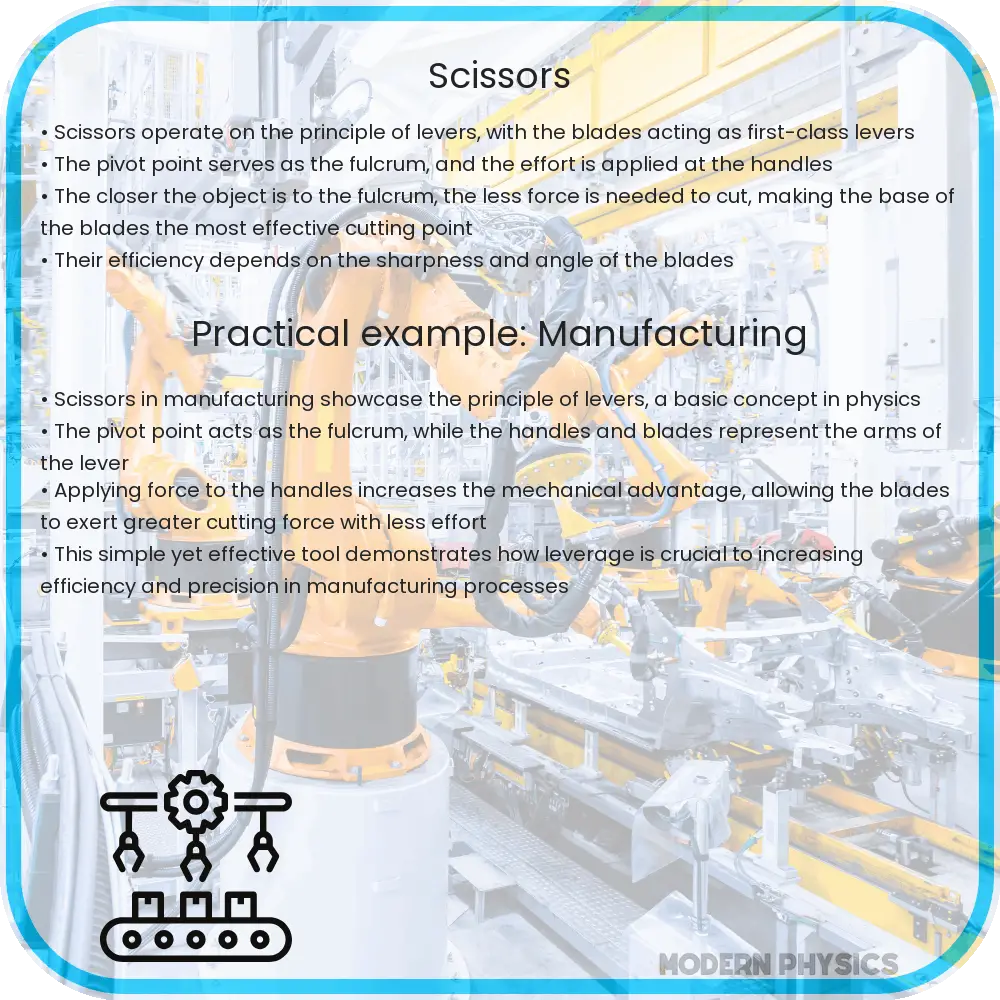Explore the mechanics of scissors in our detailed guide, covering cutting principles, force dynamics, material science, and ergonomic design.

Understanding Scissors Mechanics: Cutting Principles, Force, and Motion
The mechanics of scissors, a common yet intricate tool, involve an interplay of physical principles that govern cutting, force, and motion. This article delves into the science behind scissors, providing a comprehensive understanding of their operation, which is crucial in a variety of fields, from tailoring to surgery.
Cutting Principles
At the heart of scissor mechanics lies the basic principle of leverage. Scissors consist of two pivoted blades, where the pivot point acts as a fulcrum. When force is applied to the handles, it is magnified at the cutting edges. This leverage effect is a practical application of the basic law of moments, which states: moment = force × distance from the pivot. The longer the handles relative to the blades, the more force is amplified at the cutting edges.
Another key aspect is the angle of the blades, known as the blade angle. A smaller angle results in sharper scissors, allowing for more precise and less forceful cuts. The material of the blades also plays a crucial role, with harder materials maintaining sharpness over time, thus requiring less force to cut.
Force and Motion
The force exerted when using scissors is a combination of linear and rotational motion. The linear motion is observed when the two blades slide against each other, while rotational motion is evident as each blade rotates around the pivot point. This combination ensures that the cutting force remains constant along the length of the blade.
From a physics standpoint, the scissors exhibit a form of simple machine, transforming the input force into amplified cutting force. The efficiency of this transformation is influenced by several factors, including the sharpness of the blades, the friction at the pivot, and the angle at which the scissors are held relative to the material being cut.
Understanding the dynamics of scissors involves examining the forces at play. When cutting, the blades apply a shear force to the material. This shear force needs to exceed the material’s shear strength for cutting to occur. The distribution of this force is also critical. Ideally, it should be uniform across the cutting edge to ensure a smooth, clean cut.
The physics of scissors can be further explored through the lens of equilibrium. When in use, the forces and moments acting on the scissors must be in equilibrium. This equilibrium is crucial for effective and controlled cutting.
Mathematical Modeling and Practical Applications
Mathematically, the operation of scissors can be modeled using principles of mechanics and material science. These models help in designing scissors for specific applications by optimizing parameters like handle length, blade angle, and material properties.
In practical applications, understanding the mechanics of scissors is vital. In surgical scissors, for instance, precision and minimal force are paramount. Similarly, in textile industries, the efficiency and durability of scissors can significantly impact productivity.
In conclusion, the seemingly simple act of cutting with scissors is governed by complex interplays of mechanical principles. By understanding these principles, one can appreciate the sophistication behind this everyday tool and its diverse applications.
Advanced Concepts in Scissor Mechanics
Delving deeper into the mechanics of scissors, it’s essential to consider the role of friction and wear. Over time, friction at the pivot point can lead to wear, reducing the efficiency of the scissors. This is why regular maintenance, like oiling the pivot and sharpening the blades, is crucial for long-term performance.
Another advanced aspect is the ergonomics of scissors. The design of the handles, the angle of the blades, and the overall balance of the scissors greatly affect the user’s comfort and the precision of the cuts. Ergonomically designed scissors reduce hand fatigue and increase efficiency, especially important in professional settings like tailoring and surgery.
Chemical and Material Considerations
The materials used in scissor construction also significantly impact their performance. High-carbon stainless steel is a common choice, offering both sharpness and rust resistance. Innovations in materials science, like the use of ceramic blades, have also emerged, providing benefits such as longer-lasting sharpness and lighter weight.
Chemical treatments can further enhance scissor blades. For instance, nitriding, a process where nitrogen atoms are diffused into the blade surface, can increase hardness and corrosion resistance. This treatment can be represented chemically as: Fe x N y (where x and y denote the proportions of iron and nitrogen).
Technological Advancements and Future Directions
Technological advancements have led to the development of specialized scissors, like electric scissors, which use a motor to automate the cutting motion, significantly reducing manual effort. Moreover, the integration of computer-aided design (CAD) and manufacturing (CAM) technologies has improved the precision and customization of scissors for specific applications.
Looking ahead, the future of scissor technology may include smart scissors equipped with sensors and AI to assist in precision tasks like surgery or to guide users in learning cutting techniques. Such innovations could revolutionize how we perceive and use this age-old tool.
Conclusion
In summary, scissors are a remarkable blend of simple mechanics and complex engineering. From the basic principles of leverage and force to advanced considerations in material science and ergonomics, they embody a wide range of scientific and technological knowledge. The continuous evolution of scissor design, driven by advancements in various fields, highlights their importance in both everyday life and specialized professional domains. By understanding the dynamics and mechanics behind scissors, one can not only appreciate their functional elegance but also foresee the potential for future innovations in this essential tool.
